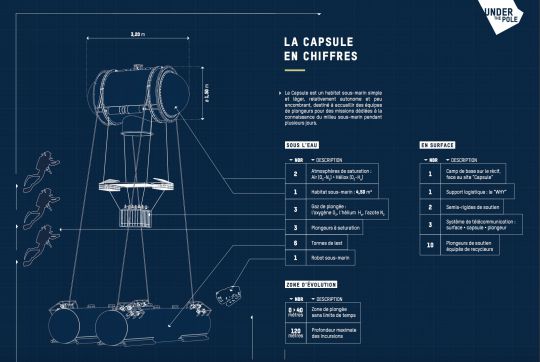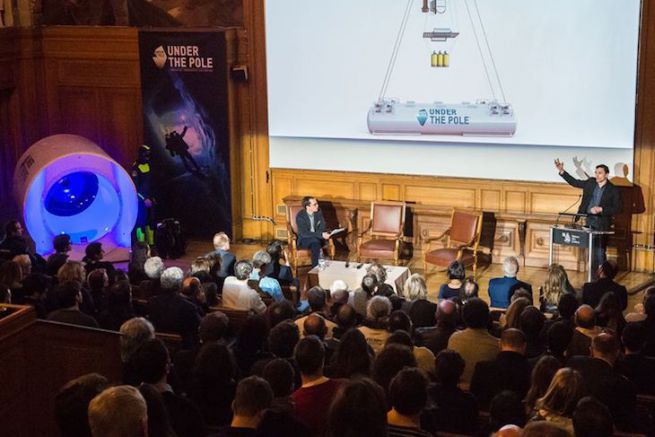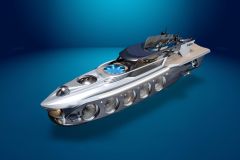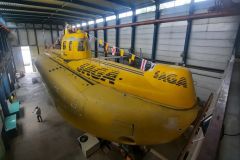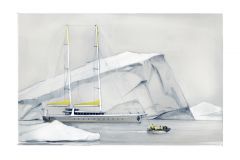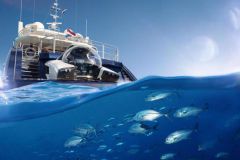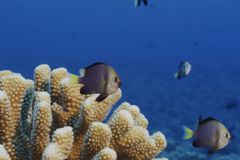The Under The Pole expeditions provide a better understanding of the underwater environment through deep dives in all the oceans of the world. But diving deeper than 100 m presents certain limits for these extreme divers. This is why Ghislain Bardout, initiator and director of Under The Pole, has presented a brand new concept for diving further and longer: the Capsule.
"I've always been fascinated by scuba diving, exploration, Commander Cousteau and his underwater adventures in the 1950s, 60s, 70s and 80s. Underwater expeditions conducted in parallel with space exploration. But today, we are at a crossroads of exploration and we are surpassed by our physical capabilities." explained Ghislain Bardout at the expedition's press conference on 15 February 2018.

Today's divers use an air recycler, the most reliable machine to date. "But the limit is no longer technology, but man. In conventional diving, you can't push the limits of humans "he adds. With an air recycler, you go down and explore for an hour or more, but you have to go back up, respect the decompression stops and eventually go back the next day, etc. Dives that are tiring for the human being.
"We wondered if this model was frozen or if we couldn't think of something else. In the forest, naturalists immerse themselves, pitch their tents and observe for hours, days, the life of the woods. It's something you can't do in the underwater environment. You go down abruptly, you stay there for several hours and then you have to come back up. So you get a truncated picture of the marine environment." adds Ghislain.
So the team focused on the concept of "how to stay on the lookout". So they developed a new underwater exploration program, to dive longer and deeper: the Capsule program.
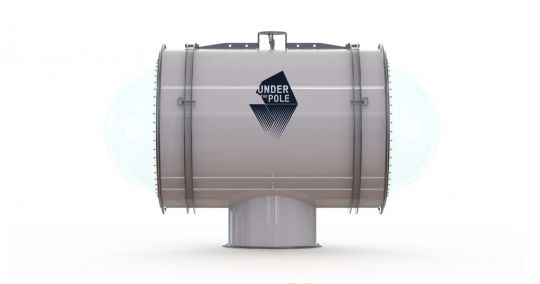
"This experimental program is overriding the codes. The Capsule is a kind of observation submarine, light and designed to make documentaries, using the principle of saturation diving. We're not inventing anything, saturation diving was widely used in the 60s and 70s, but we're modernizing it, reinterpreting it and adapting it to some kind of need." details Ghislain. This method will allow the team to dive very deep, at 200/300 m.
This project, which includes a wooden model, was developed to verify dimensions and volumes and only completes the research phase. Construction should begin in the coming months and the Capsule should be tested in French Polynesia in the summer of 2019 (June to September). "We're working with a research institute interested in animal behavior and with the University of Jussieu to study the correlation between animal acoustic meaning and behavior." explains Ghislain.
With this Capsule, there is no more time limit for diving. They will be able to spend several days without getting out of the water, retreating into this survival "base", a bit like an advanced camp for mountaineers climbing the Himalayas. On board, they will be able to sleep, eat, rest, but above all study the marine environment through the two large side portholes.
"The point is that the divers will be able to get in and out and in and out without being hindered, without being constrained..." explains Ghislain.
To design this machine, the specifications were as follows: simplicity, lightness, ability to travel anywhere in the world and transportable in a 20-foot container, ease of deployment on a site, without requiring hundreds of thousands of dollars of commissioning per day. "The Capsule meets the specifications in terms of material dimensions and weight", adds Ghislain.
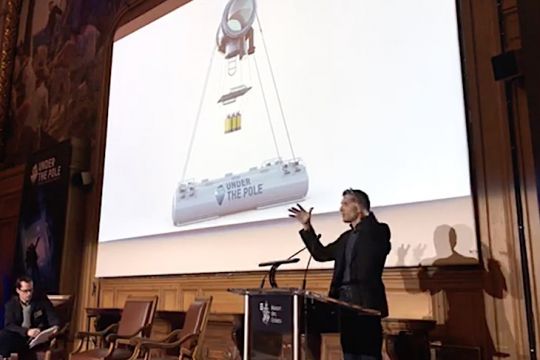
"It's a bell/bubble that allows you to live 3 days in autonomy and requires daily logistics from the surface, to bring new batteries, filters to filter the atmosphere. It uses the same technology as that of the recyclers. That is to say that the capsule will recycle the air like a rebreather, but on a larger scale, for 3 divers" details Ghislain.
"Above the capsule are installed yellow bottles that allow one day of oxygen autonomy, there is also a reserve of gas for 3 days, finally, underneath a grid allows you to climb inside the capsule. The two large cylinders are ballasts placed on the bottom. It floats when it's full of air and sinks when it's full of water. We induced a subtlety with an intermediate level that gives them a perfect neutrality in the water. In other words, there is a cylinder inside, which once filled with water keeps the ballast tank in balance. This makes it easy to move it around and put it on the bottom, at the spot we have spotted. Once filled with water and weighed down, the 2 e ballast tank and we come to fix above the capsule which floats with a 4.3 ton upward thrust since it has a volume of 4.3 m3" explains Ghislain on how this machine works.
This "somewhat Spartan" system is a starting point, a first solution for this type of underwater exploration programme. The "Why" (the schooner that navigates the team around the world) will continue to serve as a logistical support, as an intermediate relay. "Man can't stay in the marine environment for long and is forced to acclimatize. The idea with the capsule is to stay in the marine environment as long as possible to observe it." concludes Ghislain.
